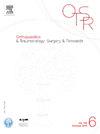Mid to long-term survivorship of hip arthroplasty in patients 40 years and younger
IF 2.3
3区 医学
Q2 ORTHOPEDICS
引用次数: 0
Abstract
Background
Etiology of hip osteoarthritis (OA) and survival of hip arthroplasty in the young (below 40-years-old) remains poorly described. Furthermore, joint survivorship mid to long-term and PROMs according to the etiology are unclear. The study aims were to 1) identify the indications for arthroplasty in the below 40-years-old cohort; 2) define hip arthroplasty outcomes in the young and 3) test whether patients with sequelae of pediatrics hip disease have inferior outcome compared to other patients.
Hypothesis
Our hypothesis was that hip arthroplasty is a viable option for managing hip disease in patients under 40, with excellent survival rates and outcomes.
Material and methods
This is an IRB approved, retrospective, consecutive, multi-surgeon, cohort study from a single academic center. Indication for hip arthroplasty of 346 patients (410 hips) below 40-years-old were studied; 239 underwent THA (58%) and 171 hip resurfacing (42%). Patient, surgical and implant factors were tested for association with implant survivorship and functional outcome for hip arthroplasty performed with a follow-up of more than two years. Pediatric hip sequelae patients were compared for survival and PROMs with the rest of the cohort.
Results
The most common etiology of OA was FAI (47%), followed by pediatric hip sequelae (18%). The 10-year survivorship was 97.2% ± 1.2, mean OHS was 45.1 ± 6.3 and mean HHS was 93.4 ± 12.6. The pediatric hip sequelae subgroup demonstrated no differences in 10-year survivorship and better PROMs compared to rest (OHS: 46.6 ± 3.8; HHS: 96.0 ± 8.5).
Discussion
The most common aetiologies amongst the young with hip OA is FAI and pediatric hip sequelae. Hip arthroplasty in the young presents excellent 10-year survivorship and PROMs. Excellent survival and PROMs in the young with pediatric hip sequelae provide important information for decision-making in this challenging population.
Level of evidence
III; retrospective cohort study.
40 岁及以下患者髋关节置换术的中长期存活率。
背景:对年轻人(40 岁以下)髋关节骨性关节炎(OA)的病因和髋关节置换术后的存活率仍然知之甚少。此外,根据病因确定的关节中长期存活率和PROM也不清楚。该研究的目的是:1)确定 40 岁以下人群进行关节置换术的适应症;2)确定年轻人进行髋关节置换术的结果;3)检验小儿髋关节疾病后遗症患者的结果是否比其他患者差:我们的假设是,髋关节置换术是治疗 40 岁以下患者髋关节疾病的可行方案,具有极佳的存活率和疗效:这是一项经美国国立卫生研究院(IRB)批准的、回顾性、连续性、多外科医师、队列研究。研究对象为346名40岁以下的患者(410个髋关节),其中239人接受了THA(58%),171人接受了髋关节置换术(42%)。对随访两年以上的髋关节置换术患者、手术和植入物因素与植入物存活率和功能结果的关系进行了检测。将小儿髋关节后遗症患者的存活率和PROMs与队列中的其他患者进行了比较:结果:OA最常见的病因是FAI(47%),其次是小儿髋关节后遗症(18%)。10年存活率为97.2%±1.2,平均OHS为45.1±6.3,平均HHS为93.4±12.6。小儿髋关节后遗症亚组与其他亚组相比,10年存活率无差异,PROMs更好(OHS:46.6 ± 3.8;HHS:96.0 ± 8.5):讨论:在患有髋关节OA的年轻人中,最常见的病因是FAI和小儿髋关节后遗症。年轻人髋关节置换术的10年存活率和PROM都很高。在患有小儿髋关节后遗症的年轻人中,出色的存活率和PROMs为这一具有挑战性的人群提供了重要的决策信息:证据等级:III;回顾性队列研究。
本文章由计算机程序翻译,如有差异,请以英文原文为准。
求助全文
约1分钟内获得全文
求助全文
来源期刊
CiteScore
5.10
自引率
26.10%
发文量
329
审稿时长
12.5 weeks
期刊介绍:
Orthopaedics & Traumatology: Surgery & Research (OTSR) publishes original scientific work in English related to all domains of orthopaedics. Original articles, Reviews, Technical notes and Concise follow-up of a former OTSR study are published in English in electronic form only and indexed in the main international databases.

 求助内容:
求助内容: 应助结果提醒方式:
应助结果提醒方式:


